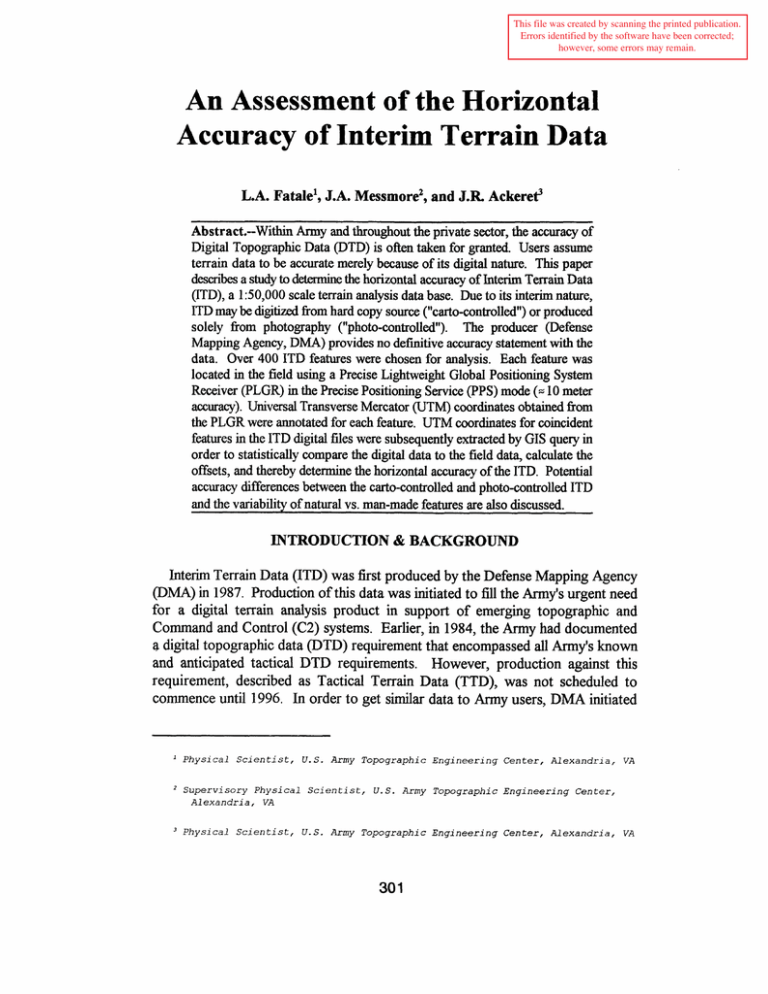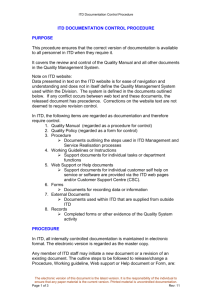Document 11863940
advertisement

This file was created by scanning the printed publication. Errors identified by the software have been corrected; however, some errors may remain. An Assessment of the Horizontal Accuracy of Interim Terrain Data L.A. Fatale1,J.A. Messmore2,and J.R Ackeret' Abstr act.--Within Army and throughout the private sector, the accuracy of Digital Topographic Data (DTD) is often taken for granted. Users assume terrain data to be accurate merely because of its digital nature. This paper describes a study to determine the horizontal accuracy of Interim Terrain Data (ITD), a 150,000 scale terrain analysis data base. Due to its interim nature, ITD may be digitized from hard copy source ("carto-controlled") or produced solely fiom photography ("photo-controlled"). The producer (Defense Mapping Agency, DMA) provides no defdtive accuracy statement with the data. Over 400 ITD features were chosen for analysis. Each feature was located in the field using a Precise Lightweight Global Positioning System Receiver (PLGR) in the Precise Positioning Service (PPS) mode (s10 meter accuracy). Universal Transverse Mercator (UTM) coordinates obtained from the PLGR were annotated for each feature. UTM coordinates for coincident features in the ITD digital files were subsequently extracted by GIs query in order to statistically compare the digital data to the field data, calculate the offsets, and thereby determine the horizontal accuracy of the ITD. Potential accuracy differences between the carto-controlled and photo-controlled ITD and the variability of natural vs. man-made features are also discussed. INTRODUCTION & BACKGROUND Interim Terrain Data (ITD) was first produced by the Defense Mapping Agency @MA) in 1987. Production of this data was initiated to fill the Army's urgent need for a digital terrain analysis product in support of emerging topographic and Command and Control (C2) systems. Earlier, in 1984, the Army had documented 8 digital topographic data (DTD) requirement that encompassed all Army's known and anticipated tactical DTD requirements. However, production against this requirement, described as Tactical Terrain Data (TTD), was not scheduled to commence until 1996. In order to get similar data to Army users, DMA initiated P h y s i c a l S c i e n t i s t , U. S . Army T o p o g r a p h i c E n g i n e e r i n g C e n t e r , A l e x a n d r i a , VA S u p e r v i s o r y P h y s i c a l S c i e n t i s t , U.S . Army T o p o g r a p h i c E n g i n e e r i n g C e n t e r , A1 e x a n d r i a , VA P h y s i c a l S c i e n t i s t , U. S . Army T o p o g r a p h i c E n g i n e e r i n g C e n t e r , A l e x a n d r i a , VA production of an interim product called ITD, the goal of which was to fill the data void until TTD production came on line. Due to the interim nature of this data set and the use of more than one production method, DMA does not state a formal horizontal accuracy measure for this product. As the center of expertise for DTD within the Army, the Digital Concepts and Analysis Center (DCAC) at the U. S. Army Topographic Engineering Center (TEC) formulated this study to characterize the horizontal accuracy of ITD. Knowledge of horizontal accuracy is important to the Army as well as other DOD users because it affects what are appropriate uses of the product. For example, is ITD as accurate as the Topographic Line Map (TLM), which may be used for targeting purposes, or is it only as accurate as a city graphic which is not an appropriate source for targeting? Fortunately, along with the need to know ITD's horizontal accuracy, technology for rapid position determination has become available in the form of Global Positioning Systems (GPS). This technology was applied to the determination of the horizontal positions of well-defined ITD features. The ITD is produced through two production processes, one is a hard-copy digitizing process, and the other is a pure photogrammetric production process. In the hard-copy process, tactical terrain analysis data base (TTADB) mylar overlays (which are geo-registered to the corresponding 150,000-scale TLM's) are digitized, thereby resulting in a "carto-controlled" ITD product. The photogrammetric production process is effected using imagery on DMA's feature extraction (FE) workstation, thereby resulting in a "photo-controlled" ITD product. It should be noted that ITD cells fiom both of these widely divergent production processes are currently distributed and in broad use. Carto-controlled cells make up the bulk of currently available ITD (= 840 of 1340 cells). The 500 remaining cells are photocontrolled. PURPOSE The purpose of this study was to provide the Mapping Charting & Geodesy (MC&G) user community with information about the horizontal accuracy of ITD features. It is intended to give the user a level of confidence in regard to ITD accuracy and to establish the utility of ITD for various applications. The study also identified accuracy differences between cartographic and photogrammetrically controlled ITD. METHODOLOGY & FIELD COLLECTION PROCEDURE To facilitate DCAC's ITD accuracy investigations, ITD hard-copy plots and digital data for 10 cells in the continental U.S. (CONUS) were obtained fiom DMA along with the associated TLEvfs. The use of the hard-copy plots @om digital ITD) instead of the TTADB ensured that features identified for analysis would be represented in the digital data. Each of these plots covered approximately a 15-by 15-minute area. There were four photo-controlled cells in the AlamagordolLas Cruces, NM area as well as six carto-controlled cells; two in the Ft. Bragg, NC, area and four in the vicinity of Ft. Hood, TX. Scientists at DCAC reviewed the hard-copy plots and identified appropriate features for field reconnaissance. Two factors weighed heavily in the selection of features. The fkst factor was the existence of a distinguishable point on the ground (e.g., a road intersection, bridge, dam, or fence line). The second factor was accessibility for measurement of its horizontal placement. No vertical accuracy criteria, such as feature height or height above mean sea level, were considered. The selected features were then annotated on the coinciding 150,000 TLM for field use. They comprised a representative sample fiom the Transportation (TRANS), Surface Drainage (SD), Obstacles (OBS), and Vegetation (VEG) overlays since these contained point or line features that were more easily recognizable in the field. Features in the Surface Configuration and Soils overlays were not utilized for this study. Although important for many applications, these features are not easily distinguishable on the ground and are difficult to measure accurately. Depending on the density of the data, between 14 and 73 features on each of the 10 cells in the study areas were chosen for analysis. The number and variety of features chosen were those deemed necessary to assure representative coverage throughout each cell. Over 400 features were subsequently visited in the field. Each site was located using a Precise Lightweight Global Positioning System Receiver (PLGR) in the Precise Positioning Service (PPS) mode (s10 meter accuracy). Universal Transverse Mercator (UTM) coordinates derived fiom the PLGR were annotated for each. ANALYSIS Data Preparation The digital ITD files provided by DMA were partitioned on the provided media (9-track tapd6250bpi) by individual sheet number and thematic layer(s). Related file header data was used to acquire descriptive information (metadata) pertaining to the individual data sets. The digital ITD files were archived in Standard Linear Format (SLF). Arc/Info (V. 7.0) was used to import the ITD-SLF files read from the tape. Upon import, the data was converted into ArcIInfo coverages using the "SLFARC" command. ArclInfots GIs fbnctionalities enabled us to: 1. Identify & display selected features by thematic layer, feature type, and feature attributes. 2. Precisely extract UTM coordinates for selected features. The Arc/Info coverages were geo-referenced in WGS-84 spherical geographic coordinates (LAT- LONG). Each coverage, maintained in single-coordinate precision (seven si@cant digits), was subsequently projected into a WGS-84 planar coordinate system (UTM) which was consistent with the GPS field collection coordinate system. Projection of coordinates fiom LAT-LON to real-world UTM coordinates via the Arc/Info projection utilities was determined to be a virtually error free process. Since both input and output coverages were stored in WGS-84 and required no additional datum transformations, the statistical sigmficance of the rootmean-square W S ) error was < 0.010. [NOTE: A perfect projection with an RMS error of 0.000 is not possible with real-world data.] Customized graphical user interfaces were developed utilizing Arc/Info's Arc Macro Language (AML) to facilitate extraction of digital ITD feature coordinates. Digital ITD Coordinate Extraction UTM coordinates for selected features were extracted in order to compare the field data to the digital data, calculate the offsets, and thereby determine the horizontal accuracy of ITD. Thematic coverages for each cell in the study area were displayed with the features appearing as unsymbolized center-line data. Next, those ground features visited in the field were interactively identified in the digital file. A coordinate pair was extracted and recorded alongside the coordinate pair of the coincident ground feature. Finally, a series of statistical analyses were performed on both sets of coordinates. Statistical Analyses Coordinates for the photo-controlled and the carto-controlled ITD features were stored in different files which were hrther delineated by eastings and northings. These files were then grouped by specific feature types (e.g., "surface drainage features from photo controlled data"). Standard statistical measures such as mean, standard deviation, 95 percent confidence interval and a t-statistic with an associated critical value were calculated for each data file. The mean and standard deviation determine the size of the error. The 95 percent confidence interval indicates the potential magnitude of that error in &re measurements. The t-statistic determines whether there is a sigdicant difference between two populations . The critical value is the threshold that the T-statistic must exceed, at a given confidence level and sample size, to ensure rejection of the null hypothesis (i.e., for this study, that there is no difference between the field data coordinates and those of the ITD data). During the field work, DCAC scientists visited 421 feature locations, collecting an easting and a northing at each for a total of 842 observations (combined photoand carto-controlled data). A summary of statistics for this data is found in Table 1. Offsets ranged fiom a low of 0 meters (pe~ectcorrespondence between field & ITD coordinates) to a high of 339 meters. The average offset for all observations was 25 meters. When the GPS measurement error (Q value) of 10 meters is included, an average offset of 15 to 35 meters is established. Table 1.-Summary of ITD Feature Coordinate Offsets # obs. (mlv) 842 V? oflet OFFSET (m) Sid W?% ogsd Low Mean High Dev. (m) 50m I OOm 0 25 339 31 7318.67 1812.14 Q 10 Q - measure of GPS error (circular) in meters E&N - Eastings & Northings Of the 842 total observations, 769 features (91.3 %) were within 50 meters of their expected locations. This is within the expected accuracy of the 150,000 Class B TLM (50 meters circular @ 90% confidence), which is the only related product with a formal accuracy statement. Only 73 features (8.7%) had fieldlITD offsets above the 50-meter TLM baseline. Further examination revealed that 18 (2.1%) of the 73 had offsets over 100 meters. As expected, 93 percent (68 of 73) of the offsets over 50 meters occurred in cartographically controlled data. These errors were especially prevalent in the SD (e.g. dams, canals), OBS, and VEG coverages where 55 of the 73 offsets were observed. Potential rationales for the higher offsets in the carto-controlled SD, OBS, and VEG coverages (vs. photo-controlled ITD) lie in DM& collection/symbolization techniques for this data as described below. In carto-controlled ITD, horizontal positioning is keyed to a base map. Although many features are collected from imagery, they are still subject to a potential offset of 50 meters (map accuracy). Moreover, SD features such as dams and canals, vegetation polygons, and especially obstacles are often displaced for symbolization purposes. Obstacles such as embankments, escarpments, ditches or road cuts may be substantially displaced to ensure the correct alignment of a stream or road bed. Moreover, it is often dacult to determine the exact start or end point of an obstacle in the field. Vegetation features are inherently characterized by their natural variability. Furthermore, ITD vegetation has a minimum areal size requirement resulting in the inclusion of many different vegetation types within a single polygon. The resulting boundaries can vary in these transition areas causing offsets. The production procedure for delineation and depiction of dams and canal endbreak points (abovehelow ground transition) is unlike that of other SD features in which positional accuracy is strictly upheld. Dam and canal lengths are often variable since they are roughly plotted to scale to provide a relative size. More emphasis is placed on the location/axis of these features rather than their sizenength. Figure 1 depicts the data offset for an actual point bridge as observed on the Gatesville, TX cell, map sheet 6446-1. The ITD bridge feature is approximately 25 meters fkom the road/stream crossing point where the field measurement took place. However, the actual position of the bridge may be as close as 15 meters or as far as 35 meters fiom its intended location depending on the GPS error introduced in the field. Table 2 illustrates various comparisons between the carto-and photo-controlled ITD at the thematic level. Cartographic feature offsets are acceptable, with some coverages performing better than others. For example, offsets for the carto transportation features averaged approximately 24 meters, while obstacles offsets approached 70 meters. The mean offset for the carto vegetation features ( ~ 2 3 m ) was comparable to transportation, but exhibited a much higher 95 percent confidence interval ( ~ 2 2 . 5vs. a4.5m). This indicates increased variability for the vegetation features and a potentially lower correlation with subsequent field observations. Overall confidence intervals for the carto-controlled features ranged fiom ~ 4 m (transportation) to ~ 5 meters 3 (obstacles). The mean offset for the cartographic data is 28.8 meters. Conversely, the mean offsets of the photo-controlled features were very low across all thematic layers. They ranged fiom a low of 10-12 meters (vegetation, surface drainage, and transportation features) to a high of 21 meters (obstacles). The 95 percent confidence intervals are fairly consistent across features ranging fkom 1.6 meters (transportation) to ~ 2 meters 2 (obstacles). The mean offset for the photo data is 13.7 meters. This is directly attributable to the increased fidelity provided by a solely photogrammetric production technique. It is recognized that statistics/comparisons for several of the feature groupings in Table 2 are based on small sample sizes (<30 observations). However, in each case the t-statistic exceeds the critical value, indicating that random error cannot explain the variance observed between the field data coordinates and those of ITD. Therefore, there is a sigtllscant difference between the populations at the 95 percent confidence level. It should also be noted that all of the ITD data used for this study was collected over areas of the continental United States (CONUS) with relatively reliable source materials. Assuming the availability of comparable sources, findings in this report should be extensible to any location. However, it is unknown to what extent, if any, foreign or other ancillary source materials may affect the results herein. Table 2.-XartoIPhoto ITD vs. Field Data Offsets by Feature & Associated Statistics Photo-Con&olled Data in meters Measurement Type Average (Mean) I Std Dev. 95% Confdenee Znt OfMean T Stiz& Crit Val. Sample Size 13.72 19.49 10.98 - 16.47 9.8 1.65 196 12.69 17.29 9.69 - 15.69 8.37 1.66 130 Obstacle features 21.31 30.85 10.19 - 32.44 3.91 1.70 32 Surf. Drainage features 11.00 11.57 5.25 - 16.75 4.04 1.74 18 Vegetation features 10.00 9.56 4.91 - 15.09 4.19 1.75 16 All features Transportation features - Carto-Controkd Data in meters 95% Conf k c e Int OfMean 28.76 32.25 26.27 - 3 1.25 Obstacle features 69.68 75.57 43.30 - 96.05 Surf. Drainage features 37.04 30.05 31.14 - 42.94 Vegetation features 23.27 25.42 12.00 - 34.54 All features Average I Std Dm. Measurement Type (Wan) Transportation features CONCLUSIONS 1. The offset of well-defined ITD features taken as a whole was approximately 25 meters. Approximately 90 percent of these features were within 50 meters of their expected locations. This meets the accuracy specification of 50 meters for a class B, 150,000-scale TLM, a traditional source for targeting information. 2. Overall, carto-controlled ITD feature offsets (29 meters) were higher than photocontrolled ITD feature offsets (14 meters). Our expectations were that the photocontrolled ITD would perform very well, as it did; however, performance of the carto-controlled ITD was also suprisingly good. 3. The positional accuracy of ITD features was determined to be compatible with the positional accuracy of hand-held precise GPS equipment currently used in the field. This accuracy compatibility will lessen the chance for codhion and correlation problems such as could occur when features are located close to one another on the ground and GPS-derived locations do not match data base locations. This problem may be more of a concern with lower accuracy data sets such as VMAP Level 1 (1:250,000 scale) and DCW (1:1,000,000 scale). ACKNOWLEDGMENTS The authors wish to extend special appreciation to Mr. John Nedza, Geographic Information Lab, Topographic Engineering Center (TEC) for the many hours of effort he provided during import of the raw Interim Terrain Data (ITD) data and subsequent conversion to Arc-Info coverages. His outstanding technical expertise greatly facilitated data analyses and played a critical role in the successfid completion of this study. The authors also wish to thank Mr. Bill Ryder, Special Studies Division, Digital Concepts and Anaysis Center, TEC for his excellent terrain analysis support during the field collection; Professor Richard Scott, Rowan College, Glassboro, N.J. for advice and insight about the statistical processes used in the report; and Messrs. Robert Gormley and David Wu, Special Studies Division, Digital Concepts and Analysis Center, TEC for their work in regard to research and compilation of the statistical analyses.



